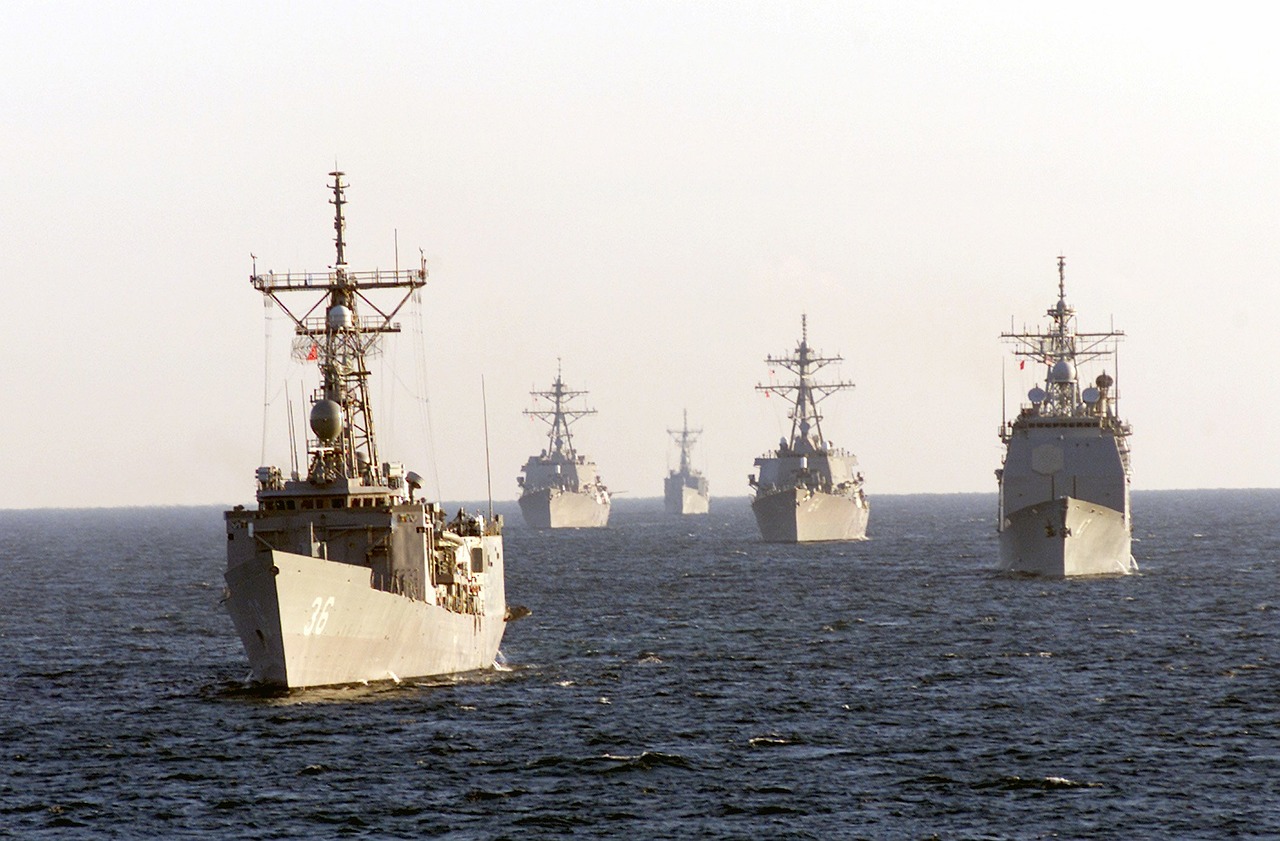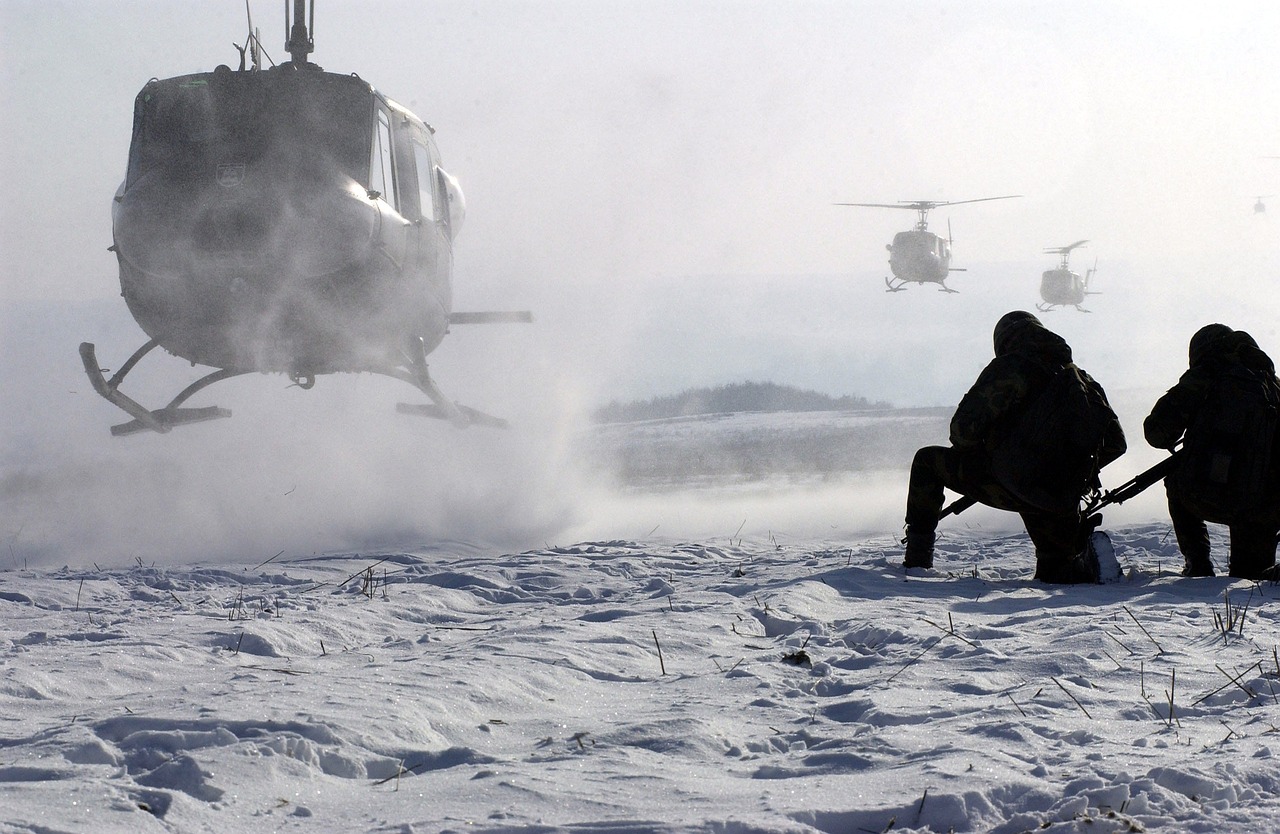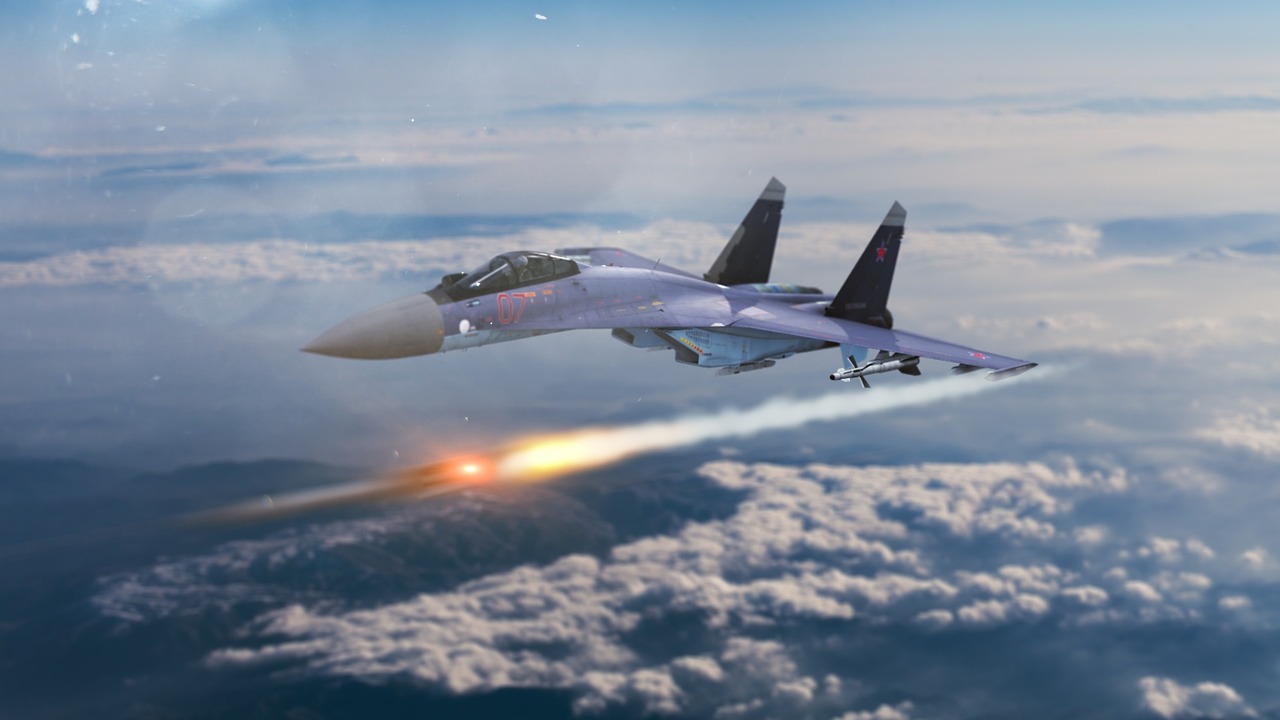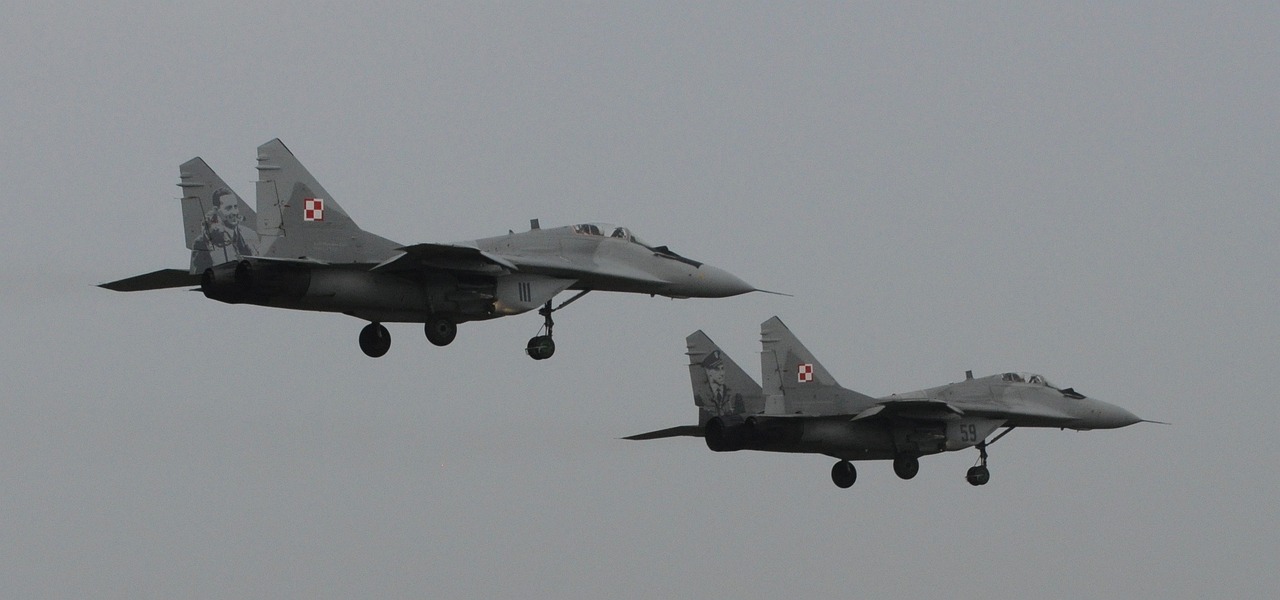Predictive Analytics in Military Intelligence
In today's rapidly evolving landscape, the role of predictive analytics in military intelligence has become increasingly vital. It’s not just about reacting to threats anymore; it’s about anticipating them. Imagine having the ability to foresee potential conflicts or identify emerging risks before they escalate. This is the power of predictive analytics. By leveraging vast amounts of data, military leaders can make informed decisions that enhance operational efficiency and strategic planning. The integration of advanced analytics tools into military operations is akin to having a crystal ball that reveals insights hidden within complex data sets.
The military operates in a world filled with uncertainties, where the stakes are incredibly high. The ability to predict outcomes based on historical data and current trends can mean the difference between success and failure on the battlefield. With predictive analytics, military intelligence can improve its response time, allocate resources more effectively, and ultimately save lives. For instance, by analyzing patterns in troop movements or communication intercepts, military strategists can make proactive decisions that mitigate risks and enhance mission success.
Moreover, the applications of predictive analytics extend far beyond just threat detection. It encompasses various aspects of military operations, including mission planning, logistics optimization, and resource management. This comprehensive approach allows military leaders to consider multiple scenarios and potential outcomes, ensuring that they are always one step ahead. The integration of this technology into military frameworks is not just a trend; it's a necessary evolution in how modern warfare is conducted.
However, as with any technological advancement, there are challenges to overcome. Issues such as data quality, integration of disparate systems, and the need for skilled personnel to interpret complex data sets can hinder the effectiveness of predictive analytics in military intelligence. Ensuring that the data being analyzed is accurate and reliable is crucial, as poor data can lead to misguided strategies and potentially disastrous outcomes. Addressing these challenges head-on will be essential for maximizing the benefits of predictive analytics in military operations.
As we look to the future, the prospects for predictive analytics in military intelligence are incredibly promising. With advancements in artificial intelligence and machine learning, the capabilities of predictive analytics are set to expand even further. This evolution will not only enhance predictive capabilities but also improve decision-making processes within the armed forces, ensuring that military operations remain effective in an increasingly complex world.
- What is predictive analytics in military intelligence?
Predictive analytics involves using data analysis techniques to forecast future events or behaviors, enabling military leaders to make proactive decisions based on anticipated outcomes. - How does predictive analytics improve decision-making?
By providing insights derived from data patterns and trends, predictive analytics allows military strategists to anticipate potential threats and effectively allocate resources. - What are the main challenges in implementing predictive analytics?
Key challenges include ensuring data quality and reliability, integrating various technologies, and the need for skilled personnel to interpret complex data sets. - What is the future of predictive analytics in military intelligence?
The future looks bright, with advancements in AI and machine learning set to enhance predictive capabilities, making military operations more efficient and effective.

The Importance of Predictive Analytics
Predictive analytics has become an indispensable tool in the realm of military intelligence. In an era where threats are constantly evolving and becoming more complex, the ability to anticipate these threats is not just an advantage but a necessity. Imagine trying to navigate through a dense fog without any visibility; that’s how military operations would feel without the insights provided by predictive analytics. This technology allows military leaders to sift through vast amounts of data, transforming it into actionable intelligence that can significantly enhance decision-making processes.
One of the primary benefits of predictive analytics is its capability to anticipate threats before they materialize. By analyzing historical data and identifying patterns, military analysts can forecast potential risks, allowing for proactive measures to be implemented. For instance, if data indicates a sudden increase in social media chatter about a specific region, military planners can investigate further, potentially averting a crisis before it escalates. This proactive stance not only saves time and resources but also enhances the safety of military personnel and civilians alike.
Moreover, predictive analytics plays a crucial role in strategic planning. Military operations are often complex, requiring the coordination of multiple resources and personnel. By leveraging predictive models, military strategists can simulate various scenarios, accounting for resource constraints and possible enemy movements. This level of foresight enables them to develop more robust plans, ensuring that they are prepared for a range of outcomes. In essence, predictive analytics acts like a crystal ball, giving military leaders a clearer view of the battlefield landscape.
Another significant advantage is the optimization of resource allocation. In military operations, resources are often limited and must be utilized effectively. Predictive analytics can help identify which units require additional support or where resources are most needed, ensuring that every asset is deployed where it can make the most impact. This is akin to a chess game, where each piece must be strategically placed to achieve victory.
In summary, the importance of predictive analytics in military intelligence cannot be overstated. It enhances decision-making capabilities, improves strategic planning, and optimizes resource allocation. As military operations become increasingly data-driven, the reliance on predictive analytics will only grow, paving the way for more informed and effective responses to emerging threats.
- What is predictive analytics?
Predictive analytics refers to the use of statistical algorithms and machine learning techniques to identify the likelihood of future outcomes based on historical data. - How does predictive analytics benefit military operations?
It helps in anticipating threats, enhancing strategic planning, and optimizing resource allocation, ultimately leading to more informed decision-making. - What challenges are associated with implementing predictive analytics in military intelligence?
Challenges include data quality issues, integration of disparate systems, and the need for skilled personnel to interpret complex data sets. - What are the future prospects of predictive analytics in the military?
Advancements in artificial intelligence and machine learning are expected to enhance predictive capabilities and improve decision-making processes in the armed forces.

Applications in Military Operations
In the realm of military operations, the application of predictive analytics is nothing short of revolutionary. Imagine having the ability to foresee potential threats and challenges before they even materialize. This foresight is made possible through advanced data analysis techniques that provide military leaders with a comprehensive understanding of the battlefield. Predictive analytics serves as a powerful tool in various aspects of military operations, including threat detection, mission planning, and logistics optimization.
One of the primary applications of predictive analytics is in threat detection. By analyzing vast amounts of data from various sources, military intelligence can identify patterns that indicate potential risks. For instance, if certain behavioral patterns emerge in specific regions, predictive models can signal a heightened risk of conflict or insurgency. This proactive approach allows military leaders to take preventive measures, ultimately saving lives and resources.
Another crucial area where predictive analytics shines is in mission planning. Military operations require meticulous planning and foresight. By leveraging data-driven insights, strategists can create comprehensive plans that consider multiple scenarios, resource availability, and enemy movements. This means that when the time comes to execute a mission, military forces are not just reacting to the situation; they are prepared for various outcomes, significantly enhancing their operational readiness.
Furthermore, predictive analytics plays a vital role in logistics optimization. Managing the supply chain efficiently is critical in military operations. Predictive models can analyze historical data and current trends to forecast supply needs, ensuring that troops are well-equipped and supported at all times. By anticipating logistical challenges, military planners can allocate resources more effectively, reducing waste and improving overall efficiency.
| Application | Description | Benefits |
|---|---|---|
| Threat Detection | Analyzing data to identify potential risks and threats. | Proactive risk management, improved safety. |
| Mission Planning | Creating strategic plans based on data-driven insights. | Enhanced operational readiness, better resource allocation. |
| Logistics Optimization | Forecasting supply needs and managing resources. | Increased efficiency, reduced waste. |
In conclusion, the integration of predictive analytics into military operations is transforming how armed forces approach challenges. By harnessing the power of data, military leaders can make informed decisions that enhance their capabilities and ensure mission success. As technology continues to evolve, the potential applications of predictive analytics in military contexts will only expand, paving the way for smarter, more efficient operations.
- What is predictive analytics in military intelligence?
Predictive analytics involves using statistical algorithms and machine learning techniques to analyze historical data and predict future outcomes, helping military leaders make informed decisions.
- How does predictive analytics improve threat detection?
By analyzing patterns and anomalies in data, predictive analytics enables military intelligence to identify potential threats before they escalate into significant challenges.
- What are the main benefits of using predictive analytics in military operations?
Some benefits include enhanced decision-making, improved operational readiness, and optimized resource allocation, leading to more effective military strategies.
- What challenges does predictive analytics face in military applications?
Challenges include data quality issues, integration of disparate systems, and the need for skilled personnel to interpret complex data sets.
- What does the future hold for predictive analytics in military intelligence?
The future looks promising, with advancements in artificial intelligence and machine learning expected to further enhance predictive capabilities and decision-making processes.

Threat Detection and Assessment
In the realm of military intelligence, are not just buzzwords; they are the backbone of strategic defense. Predictive analytics plays a pivotal role in this process by sifting through vast amounts of data to uncover patterns and anomalies that may indicate potential threats. Imagine trying to find a needle in a haystack—this is similar to what military analysts face daily. However, with the power of predictive analytics, the haystack becomes less daunting as it highlights the most critical areas to investigate.
By leveraging sophisticated algorithms and machine learning techniques, military intelligence can identify potential risks before they escalate into full-blown crises. For instance, predictive models can analyze historical data to forecast possible enemy movements or detect unusual behavior in specific regions. This proactive approach allows military leaders to make informed decisions swiftly, thereby enhancing operational readiness and minimizing risks.
Moreover, the integration of diverse data sources is essential for comprehensive threat analysis. Military analysts utilize a variety of inputs, including:
- Satellite Imagery: High-resolution images that reveal troop movements and infrastructure changes.
- Social Media: Monitoring platforms for real-time insights into public sentiment and potential unrest.
- Sensor Data: Information from drones and other surveillance tools that provide critical situational awareness.
These data points create a multidimensional view of the battlefield, enabling analysts to assess threats from various angles. Furthermore, real-time monitoring systems powered by predictive analytics can issue immediate alerts on emerging threats, which is crucial in today's fast-paced military environment. Imagine a scenario where a potential attack is detected just moments after it is planned; timely responses can significantly reduce the risks associated with surprise attacks.
In summary, the integration of predictive analytics into threat detection and assessment not only enhances the military's ability to foresee potential dangers but also strengthens its overall strategic framework. As we continue to advance technologically, the capabilities of predictive analytics will only grow, providing military intelligence with the tools necessary to stay one step ahead of adversaries.
- What is predictive analytics in military intelligence? Predictive analytics involves using statistical algorithms and machine learning techniques to analyze historical data and forecast future events, aiding military decision-making.
- How does predictive analytics enhance threat detection? It analyzes patterns and anomalies in data to identify potential risks before they escalate, allowing for proactive responses.
- What types of data are used in threat assessment? Data sources include satellite imagery, social media, and sensor data, which provide a comprehensive view of potential threats.
- What are the challenges of implementing predictive analytics? Challenges include ensuring data quality, integrating various technologies, and the need for skilled personnel to interpret complex data.

Data Sources for Threat Analysis
In the realm of military intelligence, the effectiveness of predictive analytics heavily relies on the variety and quality of data sources utilized for threat analysis. These data sources are akin to pieces of a puzzle; when assembled correctly, they create a comprehensive picture of potential dangers. Various types of data contribute to this multifaceted approach, enabling analysts to glean insights that would otherwise remain hidden. Let's dive into some key data sources that play a pivotal role in threat detection and assessment.
One of the primary sources of data is satellite imagery. This technology provides invaluable visual information about geographical terrains, troop movements, and infrastructure changes. By analyzing satellite images, military analysts can identify unusual patterns or changes that may indicate potential threats. For instance, a sudden increase in vehicle activity around a specific location could signal an impending operation or a buildup of forces.
Another significant source is social media. In today’s interconnected world, social media platforms are treasure troves of information. Military analysts monitor these platforms to gauge public sentiment, track potential insurgent activities, and even identify emerging threats. For example, a surge in posts related to anti-government sentiments can serve as an early warning signal of unrest or planned protests.
Sensor data also plays a crucial role in threat analysis. Various sensors deployed in conflict zones can collect real-time data on environmental conditions, troop movements, and even electronic signals. This data can be crucial for identifying enemy communications or movements, thus providing a tactical advantage. The integration of sensor data with other sources can enhance the accuracy of predictions and improve situational awareness.
Moreover, open-source intelligence (OSINT) has gained prominence in military operations. OSINT involves gathering information from publicly available resources, including news articles, government reports, and academic papers. This data can provide context and background information that enriches the predictive analytics process.
To summarize, the effectiveness of predictive analytics in military intelligence is significantly enhanced by a diverse array of data sources, including:
- Satellite Imagery
- Social Media Monitoring
- Sensor Data
- Open-Source Intelligence (OSINT)
By leveraging these varied data sources, military intelligence can create a robust framework for threat analysis, allowing for proactive decision-making and improved operational effectiveness. However, the challenge lies in effectively integrating these data streams into a cohesive system that can be analyzed in real-time. This integration is essential for ensuring that military leaders have the most accurate and timely information at their fingertips, ultimately leading to enhanced security and operational success.
Q: Why is predictive analytics important in military intelligence?
A: Predictive analytics helps military intelligence anticipate threats, improve strategic planning, and optimize resource allocation, leading to more informed decision-making.
Q: What are the main data sources used for threat analysis?
A: Key data sources include satellite imagery, social media, sensor data, and open-source intelligence (OSINT).
Q: How does social media contribute to military intelligence?
A: Social media provides insights into public sentiment and can help identify potential unrest or threats through the monitoring of discussions and activities.
Q: What challenges do military analysts face when using predictive analytics?
A: Analysts often encounter data quality issues, integration challenges, and the need for skilled personnel to interpret complex data sets.

Real-time Monitoring and Alerts
In the fast-paced world of military operations, real-time monitoring and alerts are not just beneficial; they are essential. Imagine a battlefield where every second counts, and the difference between victory and defeat can hinge on the timely identification of threats. This is where predictive analytics steps in, acting as the eyes and ears of military intelligence. By utilizing advanced algorithms and data processing techniques, military forces can analyze vast amounts of information almost instantaneously, allowing them to detect anomalies and emerging threats before they escalate into significant issues.
Real-time monitoring systems are designed to provide immediate alerts based on a multitude of data inputs. These inputs can range from satellite imagery and drone surveillance to sensor data collected from the battlefield. The integration of these diverse data sources creates a comprehensive situational awareness that is crucial for effective decision-making. For instance, if a sudden increase in troop movements is detected in a specific area, the system can trigger alerts, enabling commanders to assess the situation and respond proactively.
Furthermore, the predictive analytics tools can be programmed to learn from historical data, which enhances their ability to identify potential threats. This machine learning capability means that the system gets smarter over time, continuously refining its algorithms to improve accuracy and reduce false alarms. In a military context, where misinformation can lead to catastrophic outcomes, having a reliable system that minimizes error is invaluable.
To illustrate how real-time monitoring and alerts work, consider the following table that outlines the key components and their functions:
| Component | Function |
|---|---|
| Data Sources | Collect information from various platforms such as satellites, drones, and field sensors. |
| Analytics Engine | Processes incoming data to identify patterns and anomalies. |
| Alert System | Notifies military personnel of potential threats in real-time. |
| User Interface | Provides a visual representation of data and alerts for easy interpretation. |
In conclusion, the implementation of real-time monitoring and alerts through predictive analytics not only enhances the military's ability to respond to threats but also fosters a proactive mindset within military operations. By staying one step ahead, military leaders can ensure that their forces are prepared for any eventuality, thereby maintaining a tactical advantage in a constantly changing landscape.
- What is predictive analytics in military intelligence?
Predictive analytics involves using data, statistical algorithms, and machine learning techniques to identify the likelihood of future outcomes based on historical data. - How does real-time monitoring enhance military operations?
Real-time monitoring allows military forces to detect threats as they emerge, enabling quicker responses and reducing the risk of surprise attacks. - What are the challenges of implementing predictive analytics?
Challenges include ensuring data quality, integrating various technologies, and the need for skilled personnel to interpret complex data sets. - What future developments can we expect in predictive analytics for military intelligence?
Advancements in artificial intelligence and machine learning are expected to further enhance predictive capabilities, improving decision-making processes in the armed forces.

Enhancing Strategic Planning
In the realm of military operations, strategic planning is akin to playing a high-stakes game of chess, where every move counts and foresight can mean the difference between victory and defeat. By leveraging predictive analytics, military strategists can develop plans that are not only reactive but also proactive, allowing them to foresee potential challenges and opportunities. This capability transforms traditional planning methods into a dynamic process that adapts to the ever-changing landscape of warfare.
Imagine being able to anticipate the enemy's moves before they even make them. Predictive analytics utilizes vast amounts of data—ranging from historical battle outcomes to current intelligence reports—to create models that simulate various scenarios. This allows military leaders to visualize different outcomes based on their strategic choices. For instance, if a commander is considering a particular deployment, predictive analytics can provide insights into how that decision might play out under various conditions, such as enemy strength, terrain, and weather.
Moreover, the integration of predictive analytics into strategic planning enables military organizations to optimize their resource allocation. By analyzing past missions and their outcomes, military planners can identify which resources are most effective in specific scenarios. This not only streamlines operations but also ensures that troops are equipped with the right tools for the job. To illustrate this point, consider the following table:
| Scenario | Recommended Resources | Predicted Outcome |
|---|---|---|
| Urban Combat | Specialized Infantry Units, Drones | High Success Rate |
| Open Field Engagement | Tanks, Artillery Support | Moderate Success Rate |
| Cyber Warfare | Cybersecurity Teams, Intelligence Analysts | Critical Success Rate |
This table highlights how predictive analytics can guide military leaders in choosing the right resources for different scenarios, thereby enhancing overall operational efficiency. Additionally, by factoring in the likelihood of various enemy movements and responses, military strategists can craft plans that are not only flexible but also resilient to unforeseen circumstances.
However, it’s essential to recognize that the effectiveness of predictive analytics in strategic planning is heavily dependent on the quality of the data being analyzed. Poor or incomplete data can lead to misguided strategies, which is why maintaining high standards for data collection and analysis is crucial. As military organizations continue to invest in advanced technologies, the integration of artificial intelligence and machine learning will further enhance the predictive capabilities of these systems, making them indispensable tools for modern warfare.
In conclusion, predictive analytics is revolutionizing the way military strategists approach planning. By enabling a deeper understanding of potential scenarios and outcomes, it empowers military leaders to make informed decisions that can significantly improve operational readiness and effectiveness. As we look to the future, the continuous evolution of these analytical tools will undoubtedly play a pivotal role in shaping the strategies of armed forces around the world.
- What is predictive analytics in military intelligence?
Predictive analytics in military intelligence refers to the use of statistical techniques and algorithms to analyze historical data to predict future outcomes, helping military leaders make informed decisions. - How does predictive analytics enhance strategic planning?
It enhances strategic planning by providing insights into potential scenarios, optimizing resource allocation, and allowing military leaders to anticipate enemy movements. - What are the challenges of implementing predictive analytics?
Challenges include ensuring data quality, integrating various technologies, and the need for skilled personnel to interpret complex data sets. - What is the future of predictive analytics in military operations?
The future looks promising with advancements in artificial intelligence and machine learning, which will enhance predictive capabilities and improve decision-making processes.

Challenges in Implementation
Implementing predictive analytics in military intelligence is no walk in the park. While the potential benefits are immense, there are significant challenges that must be navigated to fully realize these advantages. One of the foremost issues is data quality. Imagine trying to solve a complex puzzle with missing pieces; that’s what military analysts face when the data they rely on is incomplete or inaccurate. Poor data can lead to misguided strategies and decisions, potentially putting lives at risk. Ensuring high-quality and reliable data is not just important; it's essential.
Another challenge is the integration of disparate systems. The military employs a wide range of technologies, each with its own data formats and protocols. This diversity can create compatibility issues that hinder the effective use of predictive analytics. For instance, if satellite imagery and social media data cannot be effectively combined, the resulting analysis may lack the depth needed for accurate threat assessments. Therefore, seamless integration of these various technologies is critical for maximizing the effectiveness of predictive analytics.
Moreover, the need for skilled personnel cannot be overstated. The complexity of analyzing vast amounts of data requires a workforce that is not only trained in data science but also possesses a solid understanding of military operations. This combination of skills is rare, making recruitment and training a significant hurdle. In a world where every second counts, the military must find ways to expedite the training process without sacrificing quality.
To summarize, the challenges in implementing predictive analytics in military intelligence can be categorized into three main areas:
- Data Quality and Reliability: Inaccurate or incomplete data can lead to poor decision-making.
- Integration of Technologies: Compatibility issues between different systems can hinder effective analysis.
- Skilled Personnel: The need for trained analysts who understand both data science and military operations is critical.
Addressing these challenges requires a concerted effort from military leaders, data scientists, and technology providers. By focusing on improving data quality, ensuring system integration, and investing in personnel training, the military can harness the full potential of predictive analytics to enhance its operational capabilities.
- What is predictive analytics in military intelligence?
Predictive analytics involves using statistical algorithms and machine learning techniques to analyze historical data and predict future outcomes, helping military leaders make informed decisions. - What are the main challenges in implementing predictive analytics?
Key challenges include data quality and reliability, integration of various technologies, and the need for skilled personnel to interpret complex data sets. - How can data quality affect military operations?
Poor data quality can lead to inaccurate predictions, which can result in misguided military strategies and potentially endanger lives. - Why is integration of technologies important?
Seamless integration allows for a comprehensive analysis of data from various sources, enhancing the accuracy and effectiveness of predictive analytics. - What is the future of predictive analytics in military intelligence?
The future looks promising, with advancements in artificial intelligence and machine learning set to enhance predictive capabilities and improve decision-making processes.

Data Quality and Reliability
When it comes to predictive analytics in military intelligence, the adage "garbage in, garbage out" rings especially true. The effectiveness of any predictive model hinges on the quality and reliability of the data fed into it. In military operations, where the stakes are extraordinarily high, even minor inaccuracies can lead to disastrous outcomes. Imagine planning a mission based on flawed data; it’s akin to navigating a ship through fog without a compass. You might reach your destination, but there's a significant risk of running aground or veering off course.
To ensure that predictive analytics deliver actionable insights, military organizations must prioritize data quality. This involves several key components:
- Accuracy: Data must accurately reflect the real-world conditions it represents. Inaccurate data can lead to misguided strategies and ineffective resource allocation.
- Consistency: Data should be consistent across various sources and systems. Inconsistencies can create confusion and undermine trust in the analytics process.
- Timeliness: In military contexts, having up-to-date information is crucial. Outdated data can result in decisions based on irrelevant or obsolete conditions.
- Completeness: Data sets should encompass all relevant information necessary for comprehensive analysis. Missing data can create blind spots that could be exploited by adversaries.
Moreover, the reliability of the data sources is equally important. Military analysts often rely on a variety of data streams, including satellite imagery, sensor data, and even social media. Each source comes with its own challenges regarding reliability. For instance, while satellite imagery can provide detailed geographical insights, it may not always capture real-time changes on the ground. Similarly, social media can offer valuable intelligence, but it is often rife with misinformation and must be scrutinized carefully.
To tackle these challenges, military organizations are increasingly adopting data validation techniques and employing advanced technologies such as machine learning to filter and enhance data quality. By automating the data cleaning process, they can focus on analyzing the insights rather than getting bogged down by the intricacies of data management.
In conclusion, the quality and reliability of data are paramount in the realm of predictive analytics for military intelligence. As military operations continue to evolve and become more complex, ensuring that data is accurate, consistent, timely, and complete will be essential for making informed decisions. The integration of advanced technologies will undoubtedly play a significant role in overcoming these challenges, paving the way for a future where military leaders can trust their data to guide them through the fog of uncertainty.
- What is predictive analytics in military intelligence?
Predictive analytics involves using statistical algorithms and machine learning techniques to analyze current and historical data to make predictions about future events, which is crucial for military operations.
- Why is data quality important in predictive analytics?
Data quality is vital because inaccurate or unreliable data can lead to poor decision-making, potentially endangering missions and personnel.
- How can military organizations improve data quality?
They can enhance data quality by implementing data validation techniques, ensuring consistency across sources, and utilizing advanced technologies for data cleaning.
- What role does machine learning play in military predictive analytics?
Machine learning helps automate data analysis processes, improving the accuracy and efficiency of predictive models, which is essential for timely decision-making in military contexts.

Integration of Technologies
Integrating technologies in military intelligence is not just about having the latest gadgets; it's about creating a seamless ecosystem where data flows freely and insights can be extracted in real-time. Imagine a complex web where different systems, from satellite imagery to ground sensors, communicate effortlessly. This synergy is crucial for predictive analytics to function effectively. However, achieving this level of integration is often easier said than done. Compatibility issues between old and new systems can create significant roadblocks, leading to delays and inefficiencies. For instance, if a new predictive analytics tool can’t communicate with existing databases, the entire operation can suffer.
Moreover, the sheer volume of data generated from various sources can be overwhelming. Military operations generate data from numerous channels, including:
- Satellite imagery
- Social media feeds
- Drone surveillance
- Ground sensor data
Each of these data sources has its own format and structure, making it challenging to integrate them into a cohesive analytical framework. To tackle this, military organizations must invest in robust data management systems that can standardize and streamline data from disparate sources. This is where technologies like big data analytics and cloud computing come into play, allowing for the storage and processing of large data sets in real time.
Furthermore, the need for skilled personnel cannot be overstated. The successful integration of technologies requires individuals who not only understand the technical aspects but also possess analytical skills to interpret the data effectively. This dual expertise is essential for making sense of the complex interactions between different systems and for deriving actionable insights from the data.
In summary, while the integration of technologies poses challenges, it is also a gateway to unlocking the full potential of predictive analytics in military intelligence. By overcoming compatibility issues, investing in advanced data management solutions, and cultivating a skilled workforce, military organizations can enhance their operational efficiency and decision-making capabilities.
- What is predictive analytics in military intelligence?
Predictive analytics involves using data, statistical algorithms, and machine learning techniques to identify the likelihood of future outcomes based on historical data. - What are the main benefits of integrating technologies in military operations?
Integration allows for real-time data analysis, improved communication between systems, and enhanced decision-making capabilities, ultimately leading to more effective military strategies. - What challenges are faced during the integration of technologies?
Challenges include compatibility issues between different systems, data quality concerns, and the need for skilled personnel to interpret complex data sets. - How does data quality affect predictive analytics?
High-quality data is crucial for accurate predictions; poor data can lead to misguided strategies and potentially disastrous outcomes.

Future Prospects
The future of predictive analytics in military intelligence is not just bright; it's practically glowing with potential! As technology continues to evolve, the integration of artificial intelligence (AI) and machine learning (ML) will revolutionize how military forces anticipate and respond to threats. Imagine a world where data-driven insights are not just reactive but proactive, allowing military strategists to stay one step ahead of adversaries. This is the kind of future we are looking at, and it’s already on the horizon!
With the rapid advancements in technology, we can expect several key developments in the realm of predictive analytics:
- Enhanced Data Processing: As data collection methods improve, the ability to analyze complex datasets in real-time will become a game-changer. Think of it as having a crystal ball that not only shows you the future but also provides insights on how to shape it.
- Improved Accuracy: With AI and ML algorithms capable of learning from historical data, the accuracy of predictions will significantly increase. This means fewer surprises on the battlefield and more informed decision-making.
- Integration Across Platforms: Future systems will likely see seamless integration across various military branches and allied nations, creating a unified approach to threat assessment and operational planning.
Moreover, the potential for collaboration between military and civilian sectors can lead to groundbreaking innovations. For instance, partnerships with tech companies specializing in AI can accelerate the development of predictive models that are not only sophisticated but also user-friendly for military personnel. This collaboration can result in tools that are intuitive and easily integrated into existing systems, thus enhancing operational efficiency.
However, it’s essential to recognize that with great power comes great responsibility. The ethical implications of using predictive analytics in military operations cannot be overlooked. Issues such as data privacy, the potential for bias in algorithms, and the implications of surveillance must be carefully considered. The military must strike a balance between leveraging technology for national security and upholding the values of a democratic society.
In conclusion, the future of predictive analytics in military intelligence is set to transform decision-making processes profoundly. As we embrace these technological advancements, it will be crucial to remain vigilant about the challenges they present. By addressing these challenges head-on, the military can harness the full potential of predictive analytics, ensuring that they are not just prepared for the future but are actively shaping it.
- What is predictive analytics? Predictive analytics involves using statistical algorithms and machine learning techniques to identify the likelihood of future outcomes based on historical data.
- How does predictive analytics benefit military intelligence? It helps in anticipating threats, improving strategic planning, and optimizing resource allocation, leading to more informed decision-making.
- What technologies are involved in predictive analytics? Key technologies include artificial intelligence, machine learning, big data analytics, and real-time data processing systems.
- What are the challenges of implementing predictive analytics in the military? Challenges include data quality issues, integration of various systems, and the need for skilled personnel to interpret complex data sets.
Frequently Asked Questions
- What is predictive analytics in military intelligence?
Predictive analytics in military intelligence refers to the use of statistical algorithms and machine learning techniques to analyze historical data and predict future outcomes. This helps military leaders anticipate threats, optimize resources, and improve decision-making in complex environments.
- How does predictive analytics enhance threat detection?
Predictive analytics enhances threat detection by analyzing patterns and anomalies in vast amounts of data, such as satellite imagery and social media activity. By identifying potential risks before they escalate, military intelligence can take proactive measures to mitigate threats.
- What are the main applications of predictive analytics in military operations?
The main applications of predictive analytics in military operations include threat detection, mission planning, and logistics optimization. These applications enable military leaders to make informed decisions based on data-driven insights, ultimately improving operational efficiency.
- What challenges does military intelligence face in implementing predictive analytics?
Some challenges include data quality issues, the integration of disparate systems, and the need for skilled personnel to interpret complex datasets. Poor data quality can lead to inaccurate predictions, while integration issues can hinder the effective use of predictive analytics tools.
- What data sources are utilized for threat analysis?
Various data sources are utilized for threat analysis, including satellite imagery, social media, sensor data, and intelligence reports. These sources provide military analysts with a comprehensive view of potential threats, allowing for more accurate assessments.
- How does real-time monitoring contribute to military operations?
Real-time monitoring systems powered by predictive analytics provide immediate alerts on emerging threats. This capability facilitates timely responses, reducing the risks associated with surprise attacks and enhancing overall operational readiness.
- What is the future of predictive analytics in military intelligence?
The future of predictive analytics in military intelligence looks promising, especially with advancements in artificial intelligence and machine learning. These technologies are expected to enhance predictive capabilities, making decision-making processes more efficient and effective in the armed forces.



















